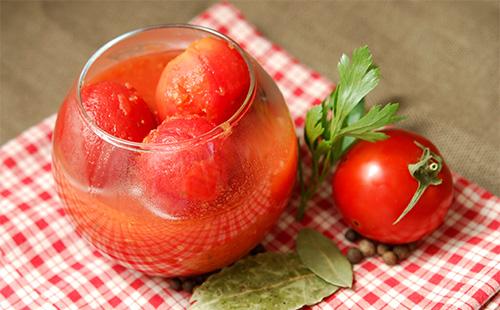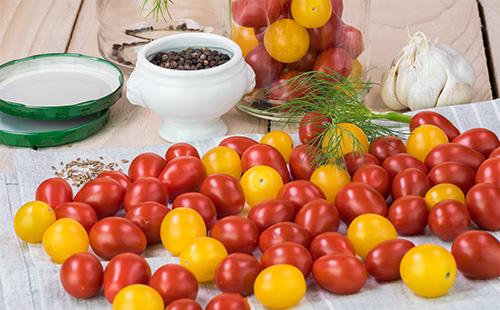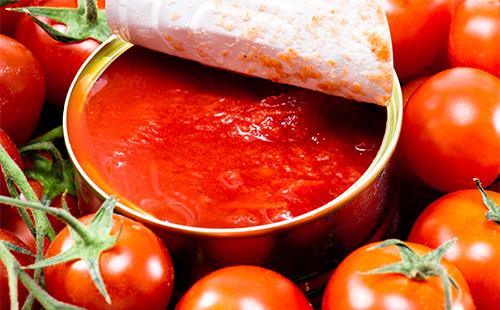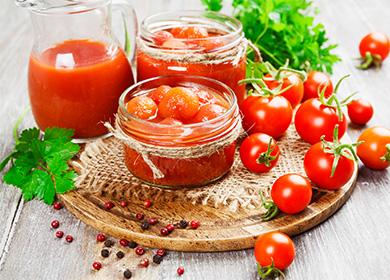Canned tomatoes in their own juice are an ideal option for those who miss the fresh and natural aroma of vegetables in the cold season. And tomatoes cooked in this way retain the maximum benefit. This is the benefit of the substances that make up the tomatoes.
- Potassium. Strengthens the heart muscle and normalizes heart rate. Regulates the central nervous system.
- Magnesium. Another "heart" substance that normalizes the heartbeat. Stimulates protein synthesis and enzyme production.
- Phosphorus. Accelerates metabolism, normalizes the genitourinary system. Strengthens bone tissue.
- Vitamin A. Prevents ophthalmic problems, has a beneficial effect on the skin condition. Strengthens the immune system and cleanses the body of toxins.
- Choline. Lowers blood cholesterol. It has a mild sedative effect.
- Pectin. It normalizes blood circulation and neutralizes toxins.
- Cellulose. Cleanses the intestines from toxins and normalizes the microflora. Regulates the work of the digestive tract.
- Sodium. Normalizes water balance, eliminates puffiness.
- Iron. It takes part in the synthesis of hemoglobin. Increases body tone and prevents anemia.
- Thiamine. Makes cell membranes less vulnerable to toxic substances. Stimulates metabolic processes.
- Vitamin C. It inhibits the aging process of the body and enhances immunity.
- Lycopene. It neutralizes free radicals and lowers cholesterol. Makes the body less vulnerable to infections.
6 secrets of delicious preservation
Conservation is a science. Before learning how to cook really tasty tomatoes that will stand all winter and not explode, the cooks and housewives had to conduct many experiments. Fortunately, today centuries-old experience is available to everyone. To prepare high-quality workpieces in your own juice, follow the six recommendations.
- Stack vegetables tightly. Fill the jars with tomatoes so that there is as little free space as possible between the fruits. But do not ram the vegetables so that they do not crumple.
- Protect fruits from cracks. Upon contact with boiling water, the peel of tomatoes often bursts. To keep the fruits whole, make two to three punctures with a toothpick.
- Wash the tomatoes thoroughly. So that the lids do not swell, and the banks do not explode, you need to rinse the fruit three times. Be sure to remove the stalk. Some housewives also prefer to cut out the place where the tomato is attached to the stem.
- Choose small cans. Roll tomatoes in containers of no more than 1.5 liters. That is how much you can eat in two to three days. Long open storage is not recommended.
- Prepare the container carefully. Check cans for integrity and wash them well with soda. This is followed by steam sterilization, in the microwave or in the oven. Do not forget to boil the lids for five to seven minutes.
- Do not taste immediately. After seaming, cans with preservation should stand for at least two weeks.
A responsible choice: 7 parameters for quality tomatoes
The result that you get at the output depends on the quality of the raw materials that you use at the input. In simple terms, a tasty harvesting of long-term storage will turn out only from good tomatoes. When choosing vegetables, consider seven key parameters.
- The aroma. Smell the tomato. You should feel a characteristic sweetish aroma. If the smell is unpleasant, then the vegetables began to deteriorate. If there is no flavor at all, then the tomatoes are unripe or grown using a large amount of chemistry.
- Appearance. Fruits should be bright red or brown. There should not be any spots, cracks or dents.
- Neighborhood. If you notice that both good and rotten tomatoes are in the same container, refuse to buy.
- The size. For this type of preservation, give preference to small fruits so that you can put them tightly in a jar. Leave large vegetables for cooking.
- Ripeness. Tomatoes for harvesting are better to choose slightly immature. This helps maintain texture and shape. And even overripe vegetables are suitable for pouring.
- Peduncle. It should be bright green and fresh in appearance. This means that the vegetable has the right degree of ripeness, and that it has been harvested recently. It’s good if the tomatoes are on a branch.
- Taste. If during the tasting of raw materials you experience pleasant sensations, then the finished product will also be tasty. If the tomatoes are acidic or too fresh, no spices will save the situation.
Step-by-step recipes of tomatoes in your own juice for the winter
Home preservation is a wide field for culinary experiments. There are many options for making tomatoes in your own juice with aromatic spices and other additives. Both experienced housewives and beginners who learn the science of homemade cooking will benefit from instructions in which the cooking steps are described step by step.
Without additives
Features If you want to enjoy the taste of fresh tomatoes at any time of the year, master a simple recipe for tomatoes in their own juice for the winter. It does not imply the use of spices, so the aroma will remain original.
You will need:
- 3 kg of small tomatoes;
- 2 kg of tomatoes for pouring;
- 80 g of salt;
- 50 g of sugar.
Cooking
- Put the prepared small tomatoes in jars.
- Cut large tomatoes and heat in a pan until soft. Wipe the product through a sieve.
- Add bulk ingredients to the juice and boil.
- Distribute the fill over the banks.
- Sterilize and roll up.
With tomato paste
Features The recipe of tomatoes in their own juice with tomato paste will save a lot of time. You do not have to make juice, just dilute the concentrate in water. The result will delight you with a rich natural taste.
You will need:
- tomatoes (how much will fit in five liter cans);
- 500 g of tomato paste;
- 4 l of water;
- black peppercorns (three for each jar);
- bay leaf (one for each jar);
- 60 g of salt;
- 20 g of sugar.
Cooking
- Put prepared tomatoes tightly in clean jars.
- Boil water with bay leaf.
- Add tomato paste. Mix the liquid well to make it homogeneous.
- Add pepper and bulk ingredients. Boil for ten minutes.
- Distribute the hot fill on the banks.Each container will take one or two cups, depending on how tightly stacked the tomatoes are.
- Sterilize and roll up.
With garlic
Features Tomatoes in their own juice with garlic are especially aromatic. A key feature of the workpiece is a large amount of sauce, which, thanks to spicy spices, is especially piquant. The number of products in the recipe is designed for four 1.5 liter jars.
You will need:
- 6 kg of tomatoes;
- garlic (five to seven cloves for each jar);
- black peppercorns (ten peas in each jar);
- sugar (a tablespoon in each jar);
- salt (half a teaspoon in each jar);
- acetylsalicylic acid (a tablet in each jar).
Cooking
- Place garlic and pepper at the bottom of each jar.
- Select small, strong tomatoes and arrange them in clean jars. Each container should be a little more than half full.
- Add salt, sugar and acetylsalicylic acid to the jars.
- Wipe the remaining tomatoes through a sieve. Boil the resulting tomato juice for 15 minutes.
- Distribute the fill on the banks, sterilize and roll up.
With horseradish
Features As a rule, tomatoes in their own juice are prepared without vinegar for the winter. This causes the hostesses some concerns about the safety of the workpiece. To dispel doubts, add sharpness to the tomatoes. Horseradish and garlic are not just flavoring additives. It is also a powerful preservative.
You will need:
- 2 kg of dense small tomatoes;
- 2 kg of tomatoes for pouring;
- 250 g of bell pepper;
- 80 g of sugar;
- 50 g of salt;
- horseradish root (about 7 cm);
- two heads of garlic;
- black peppercorns (five peas in each jar).
Cooking
- Cut the pepper into a medium sized straw.
- Fill the jar with small tomatoes. Add peas to this as well.
- Soft tomatoes, pass through a meat grinder. Boil the mashed potatoes and boil for another quarter of an hour.
- Strain the mass through a sieve and boil again.
- Chop the horseradish, chop the garlic through a press, and chop the bell pepper with a medium stripe.
- Send chopped foods and bulk ingredients to tomato juice and cook for ten minutes.
- Put boiled bell peppers in jars on top of tomatoes. Distribute juice into containers.
- Sterilize and roll up.

With olive oil
Features Fans of Italian cuisine will love the recipe for pickled tomatoes in their own juice with olive oil and aromatic basil. You get a great sauce for meat, pasta and fish. And you can put such a blank in pizza.
You will need:
- 1 kg of tomatoes;
- 100 g of fresh basil leaves;
- 100 ml of olive oil;
- three cloves of garlic;
- 15 g of salt;
- a pinch of red pepper.
Cooking
- Blanch the tomatoes, peel them and cut into halves.
- Heat olive oil in a pan, add squeezed garlic and ground pepper.
- After a couple of minutes, send the tomatoes and salt into the pan. Sprinkle with basil and stew for a quarter of an hour.
- Transfer the tomato mass into jars. Sterilize and roll up.
Cherry Juice
Features Lovers of homemade delicacies will appreciate the recipe for miniature tomatoes in tomato juice for the winter. Citric acid gives the workpiece a special piquancy and ensures long-term preservation. Small fruits “one bite” is convenient to use as a snack for alcoholic beverages.
You will need:
- 2 kg of cherry;
- 1 liter of tomato juice;
- 5 g of citric acid;
- 30 g of salt;
- 50 g of sugar;
- red bell pepper;
- bulb;
- six peas of allspice;
- four carnation inflorescences.
Cooking
- Arrange the prepared tomatoes in jars, alternating with onion rings and straws of bell pepper.
- Pour boiling water over the jars for five minutes.
- In the meantime, boil tomato juice with spices and bulk ingredients. Boil the mass and add citric acid.
- Drain the cans and fill the containers with tomato juice.
- Sterilize and roll up.

Green
Features Green tomatoes in their own juice is a savory Georgian snack. The sour taste of unripe fruits in combination with spices is well suited to spirits and aromatic barbecue. For conservation, choose fruits that are about to begin to blush.
You will need:
- 2 kg of green tomatoes;
- 5 hot peppers;
- head of garlic;
- a bunch of greens (parsley, dill, cilantro);
- salt.
Cooking
- Cut each tomato to the middle to make a pocket for the filling. Gently rub the fruit inside with salt.
- Chop the greens, finely chop the pepper, and grate the garlic. Mix foods, add a little salt.
- Stuff each tomato with herbs and pepper and garlic.
- Place the tomatoes in jars, cover and place in a cold place for two weeks. Once every two to three days, shift the upper fruits down. This is necessary in order to evenly pickle vegetables.
- In two weeks, a lot of juice should be allocated, which will fill the jar. It remains to sterilize and roll up the tanks.
No sterilization
Features If for you the process of heating cans in boiling water looks intimidating, prepare the tomatoes in your own juice without sterilization for the winter. For good preservation of the workpieces, the recipe involves the use of a small amount of vinegar.
You will need:
- 3 kg of dense whole tomatoes;
- 4 kg of tomatoes for pouring (may be overripe or with defects);
- 60 g of salt;
- 80 g of sugar;
- 5 g of cinnamon;
- ten peas of black pepper;
- five clove inflorescences;
- a tablespoon of vinegar.
Cooking
- Pour the tomatoes to be poured into small pieces and heat over low heat until soft.
- Wipe the product through a sieve. It should turn out about 3 liters of juice.
- Add spices and bulk products to the juice. Boil for a quarter of an hour.
- Arrange prepared tomatoes in sterile jars. Pour juice into containers and leave for 20 minutes.
- Gently pour the fill back into the pan and boil again. Add vinegar.
- Pour the tomato juice into the jars again and roll them up.

Sterilization: technique
Before closing blanks with covers, they must be sterilized. This procedure provides long-term storage of canned food without changing the taste. The optimal temperature for sterilization at home is the boiling point of water. The process involves four steps.
- Training. Pour water into a special sterilizer or ordinary large pan.
- Protection. So that the jars do not burst from touching the hot bottom of the pan, you need to put a tissue napkin in the pan. You can also put a special grill on the bottom.
- The heating. Put a pot of water on the fire. When the water warms up to 30-40 ° C, lower the jars. Cover the containers with lids.
- Sterilization. From the moment the water begins to boil, the sterilization process begins. For small cans with a volume of 0.5-0.7 liters, ten minutes is enough. Tanks with a volume of 1-1.5 liters are processed for 15-20 minutes. Large bottles should be heated for about half an hour.
Interestingly, a couple of hundred years ago, tomatoes were considered poisonous. They were used only in landscape design and as home decorative plants. And only in 1820, the brave American Robert Gibbon Johnson denied this error. The amazed crowd watched in horror as the colonel eats red fruits one by one. When it became clear that the eater was alive and well and feeling excellent, the myth was debunked. Having tasted the fragrant fruit, people could no longer refuse it. Share this story with your loved ones as you gobble up tomatoes for the winter in their own juice.
"Very relevant for cores," - reviews of the hostesses
In your own juice, your favorite recipe. I do it every year. It is really not only very tasty, but also incredibly healthy. A very relevant recipe for people suffering from cardiovascular diseases. I have arrhythmia and this product constantly supports me. Indeed, in the middle of summer in tomatoes a lot of vitamin and you can save them for the whole year only with the help of blanks. Be healthy!
Olga https://nazimu.net/tomatos/pomidoryi-v-sobstvennom-soku#i-3
So the tomatoes rolled up in September were used! Sooo tasty. The whole family now asks only to do it in their own juice. I tried it differently and with spices and only with sugar and salt, everything turned out to be awesome !!!! By the way, there were a lot of yellows small and sweet, I ordered them in juice from red. And beautiful and delicious !!!
Olga Kosheleva, http://ovkuse.ru/recipes/pomidoryi-v-sobstvennom-soku/
Other salad recipes
Zucchini salads for the winter
Mother-in-law's tongue from zucchini for the winter
Eggplant mother-in-law salad
Eggplant salad for winter

